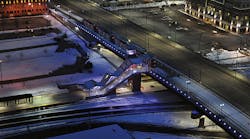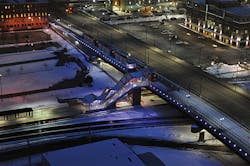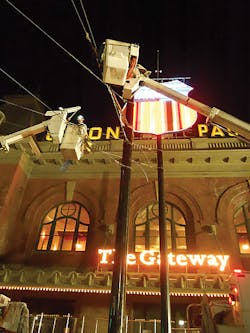Salt Lake City-bound travelers can now land at the airport, jump on a light rail train, and venture to the heart of the city. By building a 6.2-mile extension, the construction team created a new gateway to downtown.
Through a partnership with the Utah Transit Authority (UTA) and Salt Lake City, Stacy and Witbeck (a civil contractor specializing in transportation projects) and Kiewet (a construction, mining, and engineering firm) finished the job not only ahead of the 2015 schedule, but also $27 million under the $250 million budget, says Ryan Snow, project manager for Stacy and Witbeck. The light rail extension project was part of the UTA’s 2015 capital development program to build 70 miles of new rail line over a seven-year time span.
The Airport Extension, a part of the 2015 Capital Improvement program for UTA, was critical in doubling the capacity of the existing system.
On the Salt Lake City Transit Authority (TRAX) project, the joint venture partners turned to two electrical firms: Salt Lake City-based Hidden Peak Electric Co., Inc., and Irving, Texas-based Mass. Electric Construction Co. While Hidden Peak Electric worked on the signalized traffic intersections for the trains and the street/station lighting, Mass. Electric Construction Co. handled the systems work, installation of fiber-optic cabling, and train control, including the overhead catenary systems (OCS).
Troy Grill, project sponsor for Mass. Electric, says although the project was challenging, it also had more of an iconic feel to it than other jobs he has worked on.
“The new line goes right down the middle of North Temple Street,” says Grill. “As the area is coming alive, it will spread to the rest of the community as they start using this new asset.”
Incorporating innovation
The project team deployed a number of technological innovations within the light-rail structure on the project. For example, the construction team reduced the size of the drill shaft foundations, used cellular concrete in some of the bridge embankments, and took a creative approach to the sequence of the work. In addition, the crews built the road and track as two independent structures, which allowed the team to mitigate the impact on traffic while the bridge was taken out of service.
Along with constructing the structure to support the double-track light rail, the field workforce also built a new viaduct crossing over an existing commuter rail, added six stations and a welcome center at the airport, and handled roadway and surface improvements along the entire corridor.
Like other transit jobs, the project was completed in phases. The utility work was finished first, followed by the roadway lighting phase. Next, the team constructed the light rail corridor in the middle of the roadway, built embedded station platforms, and then focused on the overhead electrical work. Finally, the project moved into the safety certification and integration phase to ensure the line was safe and operable before running trains on the new light rail extension.
To maximize quality and efficiency, Mass. Electric prefabricated all of the OCS supports and assemblies in a controlled facility prior to starting operations. Once the track work was completed, Mass. Electric crews installed poles and supports every 100 ft along the track alignment. Next, the linemen pulled the wire along the length of track, registering it at every structure at a position about 10 in. from the track centerline. Once the wire was installed, the teams completed a joint inspection to ensure the system was ready for the next phase of testing.
The construction team also installed signalized interlockings for the train control system. Any time the train was set to move down the track, it had to pass over track circuits used to control train location, switch points, and at-grade crossings. The signal on the track senses when the train is approaching a switch or crossing. While this train is moving down the path, it doesn’t allow any other trains to enter that particular zone. To make this happen, the workers had to install an 8-ft by 12-ft stainless steel structure called a “signal house.” This structure was equipped with computer processors, which served as the brains to control the movement and location of the trains at all times.
Facing challenges
At the peak of the job, 300 craft workers were on the job site, including 40 linemen and electricians from Mass. Electric. Multiple supervisors and engineers coordinated the team of field workers and developed daily game plans. Every foreman and subcontractor met each day to coordinate with other workers and ensure they didn’t get in each other’s way. The main focus of this effort was worker and public safety.
One of the most significant challenges on the job site was the location of the work, explains Snow. As a result of where the field crews were working, it required very tight coordination and a significant amount of public outreach to maintain communication with the stakeholders, state transportation authorities, city, UTA, and special interest groups on the line.
The new light-rail line crossed through a downtown area via North Temple Street. As a result, the workers were working in an area with live traffic on both sides.
“Even routine tasks were challenging due to the access to the work,” says Grill.
Another challenging aspect of the project from the electrical perspective was tying the new light-rail into the existing system downtown. The team had to ensure that everything integrated seamlessly together, and they only had 21 days to perform the tie-in work and get it up and running.
To allow other trades to safely complete the civil and track work, the workers had to isolate the electrical systems, which took about 13 of the 21 days. Once the track was in its final location, the systems and electrical work could begin.
Leading up to the three-week outage, the linemen completed as much preparatory work as possible around this location without interrupting the train service. As a result, they were able to minimize the amount of work they had to do during the outage.
For example, Mass. Electric shaved three days off the three-week schedule by back pulling all the OCS wire and installing it in the air prior to the completion of the track. By working together, the track crews and Mass. Electric workers were able to execute the plan without interrupting the track operations.
Community outreach
A new light rail project connected not only Salt Lake City’s airport with its downtown area, but also the construction team with the local community. While building the 6.2-mile light rail extension, Stacy and Witbeck and Kiewit developed an outreach program involving more than 120 businesses served by the new line.
For example, field workers collected donations for a local transitional housing facility for veterans. As a result, the residents received a full Thanksgiving dinner, new community room furniture, and a big screen television. Stacy and Witbeck and Kiewit also adopted a local high school serving low-income students.
“When we go into a project, we don’t just build it, but we embed ourselves in the community,” says Snow. “It truly was a great partnership, and I think you can see that in the employees, who were excited to come to work each day. It reflected the sentiment of everyone who worked on the project.”
Grill says the companies inspired the subcontractors to also get involved with the volunteer projects in the community, such as a charity golf tournament.
“By branching beyond just working on the project together, it created a great team atmosphere,” says Grill. “Anything that they did in the community, we tried to join them. It led to team unity.”
By their involvement with the community, the team won the American General Contractors Service in the Community award. By not just focusing on building the transit line, but also by involving the local community, the team was able to revitalize downtown Salt Lake City and provide a new transportation option from the airport to the city.
Fischbach is a freelance writer based in Overland Park, Kansas. She can be reached at [email protected].
For more images and details about the TRAX Project, visit our photo gallery.





